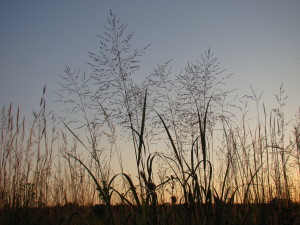Setting the Stage
The Intersection of Three Problems
Although the average Midwesterner may not realize this, Eastern Tallgrass Prairie is one of the most critically endangered ecosystems on earth. This diverse set of plants and animals that used to cover much of the heart of North America is now so rare that many people have never even seen it. Nationwide, greater than 96% of this ecosystem has been lost1; in states such as Iowa and Illinois, 99.9% of prairies are gone. Because prairies build rich soils and are relatively easy to plow, this ecosystem has been converted to agricultural fields, urban areas, and other human landscapes at an alarming rate. Due to this rate of habitat loss, many prairie organisms are declining in numbers3. Furthermore, the fact that most remaining patches of un-plowed prairie are small and isolated from each other creates a serious set of problems for organisms, an issue called habitat fragmentation.
Global climate change is an undeniable reality4,5. Through accumulation of carbon dioxide, methane, nitrous oxide, and other greenhouse gases in the atmosphere, worldwide temperatures are rising with far-reaching negative consequences. As indicators of the severity of this issue, scientists estimate that 15 – 37% of all species face extinction from global warming by 20506 and predict that 370 million humans likely will be forced to relocate by 2100 because of rising ocean levels7.
Increasing costs (both economic and environmental) and dwindling supplies of fossil fuels indicate now is the time for new sources of energy. Grain-based biofuels, such as corn-produced ethanol, are marketed as a mechanism of reducing greenhouse gases. While using ethanol from corn kernels does reduce CO2 emissions compared to gasoline, this reduction is small (10 – 15%) since growing and harvesting corn consumes large quantities of fuel8. Furthermore, since corn also feeds humans and livestock, the use of this crop for fuel creates excessive demand, likely leading to higher grain and food prices9 and further loss of wildlife habitat10,11.
The Promise of Prairies
Prairie plants have tremendous potential to provide benefits in agriculture, including the production of fuel. Research in
Minnesota8 has shown that diverse plantings of prairie vegetation produce more biomass per acre than other crops (including corn and plantings of switch grass alone). This biomass can be used to produce liquid fuels and to create electricity. These prairie plantings can be grown on poor soils and require little to no input of water, herbicides, pesticides, or fertilizers. Furthermore, little fuel is used maintaining the plantings and the diverse vegetation stores large quantities of carbon in the soil12. Therefore using fuels or electricity from this source may consume more CO2 than is released8. Additionally, diverse plantings of prairie vegetation potentially provide other benefits to agriculture and the environment13 (see objectives page), services that likely outweigh the cost of planting.


